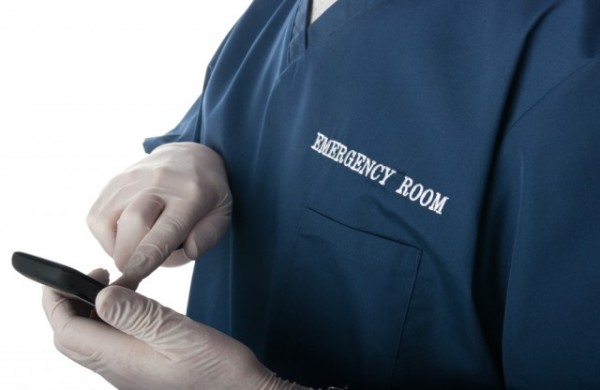
Going to the doctor and getting your chest bumped and your arm squeezed might feel reassuring, but the physical, like primary care physicians, is on the wane. The good news is that we’re likely to be a lot better at testing, monitoring, and interpreting the data we get. Gizmos will change the game. In advance of the Zócalo event “How Can Biomedicine Fulfill Its Promise?” three medical professionals offer a forecast of what to expect from the physical of tomorrow.
Say goodbye to the routine physical
 What will change most about our routine physicals over the next decade is that they will not exist. The truth is, routine physical exams are largely useless. Even the AMA states that the primary value of the physical is to maintain a personal connection to your physician–not to discover health problems early. If we can get our political and social act together, we have the technological capability to revolutionize how we monitor our health. Biometric information (temperature, blood pressure, etc.) will be monitored wirelessly on each individual for retrieval and analysis. People are already starting to do this.
What will change most about our routine physicals over the next decade is that they will not exist. The truth is, routine physical exams are largely useless. Even the AMA states that the primary value of the physical is to maintain a personal connection to your physician–not to discover health problems early. If we can get our political and social act together, we have the technological capability to revolutionize how we monitor our health. Biometric information (temperature, blood pressure, etc.) will be monitored wirelessly on each individual for retrieval and analysis. People are already starting to do this.
What will change things most is that we will have the means to routinely and comprehensively screen ourselves for any disturbance in health. A patient will regularly mail in a drop of blood or saliva for analysis. Within days, a central lab will post the results to the patient’s personal web site, and screening will allow for the detection of the earliest stages of almost any disease. The data will be yours to share and analyze as you wish.
Eventually, instruments for reading your blood or saliva samples will be in your home. It will essentially be real-time monitoring. The data will be yours to control. The word “patient” will have passed from the lexicon.
Dr. Stephen Johnston co-directs with Dr. Neal Woodbury at the Center for Innovations in Medicine (CIM) at the Biodesign Institute at Arizona State University.
————————————-
We’ll get our care online–but fancy technology comes with new costs
 The healthcare systems of most developed countries are organized to provide all the care you need, whether or not you can afford it. America’s healthcare system is aligned to provide all the healthcare you can afford, whether or not you need it. As a result, Americans pay more for their healthcare than anyone else on earth. No other country comes close.
The healthcare systems of most developed countries are organized to provide all the care you need, whether or not you can afford it. America’s healthcare system is aligned to provide all the healthcare you can afford, whether or not you need it. As a result, Americans pay more for their healthcare than anyone else on earth. No other country comes close.
Americans can be justifiably proud of their prowess in biomedical research, but this knowledge has to be applied carefully. Otherwise, the “promise” of biomedicine could prove to be a curse. Rather than getting a routine physical in 10 years, much of our preventive care will be accomplished online. Will preventive care in the future also include an analysis of each person’s genetic code? I hope not.
We hear a lot about the benefits of genomics but very little about its risks. These include: false-positive test results that trigger needless worry and costly diagnostic workups; the detection of a gene that might (but probably won’t) cause problems later in life; labeling otherwise healthy people “high risk,” potentially rendering them uninsurable and possibly unemployable, and the prospect of consigning hundreds of thousands–perhaps millions–to an interminable series of doctor visits, follow-up tests, and treatments to prevent disease in a few.
In a nation long fearful of healthcare rationing, we are just beginning to come to grips with the opposite problem–the enormous costs and grievous harm that come from excessive testing and needless treatments. Don’t forget–an American’s odds of living a long and healthy life still depend more on his zip code than his genetic code. That won’t change until we make healthcare more affordable.
Dr. Arthur Kellermann, an emergency physician, holds the Paul-O’Neill-Alcoa Chair in Policy Analysis at the nonprofit, nonpartisan RAND Corporation.
————————————-
We’ll have Onstar for the body
 In the future, medical exams will be personalized and tailored to the individual, to a person’s specific genetic profile. Some exams will be annual, some monthly. Some will be augmented by telemedicine or other forms of contact between the patient and clinical care team, but in-office visits will be far fewer.
In the future, medical exams will be personalized and tailored to the individual, to a person’s specific genetic profile. Some exams will be annual, some monthly. Some will be augmented by telemedicine or other forms of contact between the patient and clinical care team, but in-office visits will be far fewer.
Medical devices will allow for steady, rather than occasional, monitoring. Instead of a doctor performing a random spot check once a year, a widening array of mobile devices, including wearable sensors, will monitor blood pressure, blood sugar and other health-related metrics on a steady basis. Among the devices to expect: mobile-phone-connected blood-pressure cuffs, wearable pedometers to track exercise regimens, sleep monitors, even home-based “medical tricorders,” for which an X-prize was recently launched.
Artificial Intelligence (AI), or, as I prefer to call it, IA (Intelligence Augmentation) will play an important role in interpreting the data, helping to correlate signs and symptoms. It will also offer clinical guidelines and other information to augment the skills and decision-making of the clinician, who in many cases will be a nurse practitioner.
To prevent an overflow of information from multiple sources, data will need to be integrated into dashboards to lead to meaningful and actionable information. I envision integrated systems similar to those of modern cars, which have hundreds of sensors and an onboard diagnostic computer which can help detect problems early and indicate to the driver what is going on. All of us will have Onstar for the body.
Daniel Kraft, MD, is executive director of FutureMed.
*Photo courtesy of Shutterstock.



